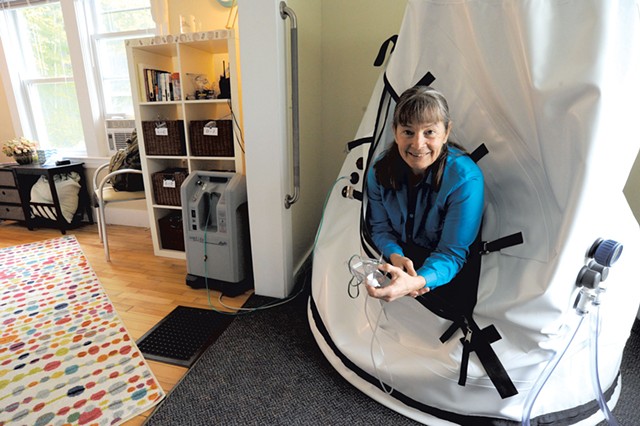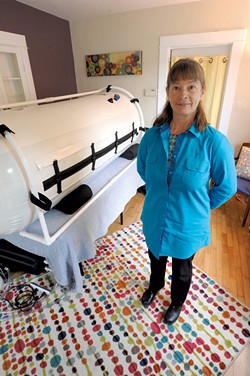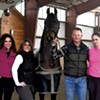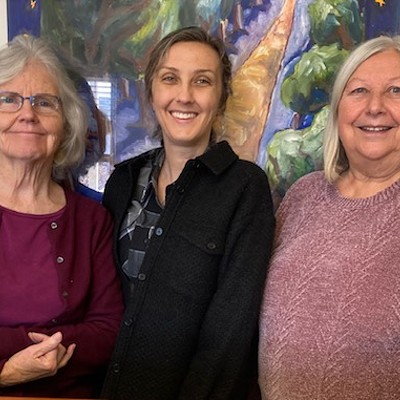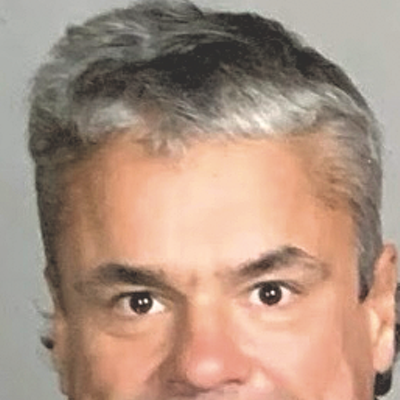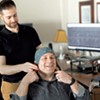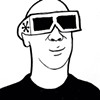Switch to the mobile version of this page.
Vermont's Independent Voice
- News
- Arts+Culture
- Home+Design
- Food
- Cannabis
- Music
- On Screen
- Events
- Jobs
- Obituaries
- Classifieds
- Personals
Browse News
Departments
Browse Arts + Culture
View All
local resources
Browse Food + Drink
View All
Browse Cannabis
View All
-
Culture

'Cannasations' Podcaster Kris Brown Aims to 'Humanize'…
-
True 802

A Burlington Cannabis Shop Plans to Host…
-
Business

Judge Tosses Burlington Cannabiz Owner's Lawsuit
-
Health + Fitness

Vermont's Cannabis Nurse Hotline Answers Health Questions…
-
Business

Waterbury Couple Buy Rare Vermont Cannabis License
Browse Music
View All
Browse On Screen
Browse Events
Browse Classifieds
Browse Personals
-

If you're looking for "I Spys," dating or LTRs, this is your scene.
View Profiles
Special Reports
Pubs+More
Is Hyperbaric Oxygen a 'Miracle Cure'?
Published May 31, 2017 at 10:00 a.m. | Updated August 14, 2019 at 12:07 p.m.
Mary Kay Blouin felt like she was living in a state of perpetual exhaustion. After a couple of falls on pavement in the last two years left her with a traumatic brain injury — while she was recovering from Lyme disease — the Middlesex woman says she woke up every morning experiencing headaches, memory loss, brain fog, digestion problems, and joint and muscle pain.
"I felt like I was wearing this gray blanket, a kind of heavy, exhausted [and] dull existence," recalls Blouin, who is co-owner of the candy store Delish Montpelier's Sweet Shop.
But last winter, Blouin found significant relief from her symptoms after undergoing an unconventional form of therapy with Dr. Grace Johnstone, a chiropractor in East Hardwick for the past 24 years. In January 2014, Johnstone began offering hyperbaric oxygen therapy, or HBOT, to patients suffering from ailments that weren't responding to medication or other forms of treatment.
Initially, Blouin says, her symptoms worsened slightly after her first hourlong session inside the hyperbaric chamber. But, after three weeks of treatments two or three times a week, she says, she felt renewed energy and mental clarity for the first time in months.
"I didn't remember the last time I'd felt like myself," she says. "It was shocking that nobody was talking about this."
HBOT involves exposing patients to concentrated levels of oxygen at higher-than-normal atmospheric pressure in order to, as Johnstone puts it, "enhance the body's natural ability to heal." By increasing the pressure, she explains, HBOT boosts the body's ability to absorb oxygen, provides anti-inflammatory and antimicrobial effects, speeds the body's ability to repair itself, and boosts the immune system.
HBOT isn't new technology. The Irish physicist and inventor Robert Boyle first experimented with it in the mid-1600s; clinical applications started a couple of centuries later. By the mid-20th century, physicians were using hyperbaric chambers to treat medical emergencies brought on by undersea diving, such as gas embolisms and decompression sickness.
Today, HBOT is standard for more than a dozen serious medical conditions, including carbon monoxide poisoning, radiation and thermal burns, crush injuries, severe anemia, and persistent diabetic wounds.
In the last 10 to 15 years, practitioners including Johnstone have begun using HBOT for ailments other than the 14 for which it's currently approved by the U.S. Food and Drug Administration. Such "off-label" uses, which are legal but require a doctor's prescription, are given to patients with dementia, multiple sclerosis, Parkinson's disease, stroke, traumatic brain injury and post-traumatic stress disorder, among other conditions.
HBOT has also entered the realm of sports rehabilitation and general wellness. Elite athletes such as golfer Tiger Woods, Olympic gold-medal swimmer Michael Phelps and NBA star LeBron James reportedly have used it to recover more quickly from injuries and speed recuperation after major competitions.
Hyperbaric chambers were once found only in major hospitals and cost several thousand dollars for a single session. But they have found their way into small alternative health clinics and spa-like settings around the country, usually for a fraction of the price that hospitals charge. In cities such as New York and San Francisco, a single hourlong session in a hyperbaric chamber can run as much as $300. By contrast, Johnstone's Community Hyperbaric offers package deals for hourlong sessions for as little as $45.
In Vermont, medical doctors as well as doctors of osteopathy, naturopaths and chiropractors can write a prescription, though insurance typically covers only FDA-approved applications.
In March 2016, Community Hyperbaric opened a second office, in Montpelier. Located in a converted house on River Street, the interior looks more like a therapist's office than a medical facility. A steady hiss of venting air emanates from behind French doors, where two white, soft-sided hyperbaric chambers are located.
One, about the size of a large pool table, is roomy enough for a patient to recline. The other, a smaller chamber designed for sitting upright, is better suited for a patient in a wheelchair or someone who needs an assistant nearby. In either chamber, the patient breathes concentrated oxygen through a mask or nasal cannula.
Despite HBOT's fast-growing popularity elsewhere in the country, the technology is still largely unknown and unavailable throughout Vermont. Some in the state's medical community, including staff at the Vermont Medical Society, said they were unaware that it's now being offered outside of traditional hospital settings.
Several local physicians contacted for this story said they'd heard about HBOT's off-label uses. However, most expressed skepticism about its curative properties, noting the dearth of peer-reviewed research in the United States to validate its purported benefits.
Dr. Peter Moses, a gastroenterologist at the University of Vermont Medical Center, was asked about recent research claiming that HBOT may help patients with ulcerative colitis. Moses finds such claims dubious.
"There isn't a lick of data to support the use of HBOT for [irritable bowel disorder] or for nearly any systemic disorder, for that matter," Moses writes via email. "This is a technology that has been searching for a clinical niche for some time."
Similarly, Dr. Joe McSherry, a UVMMC neurologist, reports that he isn't aware of HBOT's off-label uses but characterizes it as "a fairly harmless placebo."
But Johnstone, a doctor of chiropractic who holds a national certification in undersea and hyperbaric medicine, begs to differ. She's been researching HBOT for more than three years, including how it's used elsewhere in the industrialized world. She asserts that American physicians' misunderstandings or misgivings about HBOT stem from the fact that American medical schools teach little or nothing about mild (lower-pressure) hyperbaric therapy.
Traditional hyperbaric chambers, Johnsone explains, typically use 100 percent pure oxygen at pressures as great as 2.4 ATA, which is nearly two and a half times the average atmospheric pressure at sea level. By contrast, mild HBOT — the kind she uses — applies just 1.3 ATA, with 90 to 95 percent oxygen content. (Normal dry air is 21 percent oxygen.) Using lower pressures and oxygen concentration reduces the dangers of fire and explosion associated with 100 percent oxygen delivered from pressurized tanks. It's also more effective in treating certain conditions, Johnsone says, while minimizing the risk of complications typically caused by high-pressure hyperbaric therapy, including lung or sinus damage, vision loss, and oxygen toxicity.
"As safety goes," she adds, mild HBOT is "probably safer than crossing the street."
Johnstone first discovered HBOT after she contracted Lyme disease in July 2012, which led to meningitis and radiculoneuritis, which is inflammation of one or more roots of the spinal nerves. After a month of intravenous antibiotics and multiple trips to the emergency room, her Lyme symptoms reemerged.
"It was completely incapacitating for me. I couldn't walk. I couldn't read. I couldn't drive," recalls Johnstone. She didn't return to work for more than a year.
Then Johnstone met a woman whose daughter had Lyme and suffered from unexplained seizures. They had an HBOT chamber in their home and, in April 2013, offered Johnstone an opportunity to try it.
"For me, the first time [using HBOT], I could tell this was helping my brain," she recalls. Johnstone's earache, which she'd had for nine months, disappeared immediately, and she says she felt much more relaxed. "For me, it was the beginning of getting my life back," Johnstone says.
She eventually took out a bank loan and bought herself a hyperbaric chamber — for $21,000. Since then, the price has dropped considerably. One of the two in her Montpelier office cost $7,500; online, some sell for as little as $3,800.
Although hyperbaric therapy is still "vastly underutilized" in the United States, Johnstone says, much of the industrialized world considers it mainstream medical therapy. In the UK, for instance, the National Health Service covers the cost of treating multiple sclerosis with mild HBOT.
Some of the most promising results, she notes, have been in the field of neuroscience, especially among patients with multiple concussions or strokes, or who have undergone brain surgery for cancers. Johnstone cites studies done overseas showing that HBOT can increase the brain's neuroplasticity, or ability to heal, grow and regenerate blood vessels and neural connections.
"We're just seeing tremendous response ... and what's amazing is that we're seeing this even years after the stroke or concussion," she adds. "That's very unique to this treatment."
Even if many Vermont physicians haven't heard about HBOT or scoff at it, patients are starting to ask about it. Dr. Katherine Wayman is an assistant professor of neurology and a headache medicine specialist at UVMMC. She says that, after a half dozen of her patients reported positive experiences with HBOT and "many more" inquired about it, she attended one of Johnstone's presentations "with an open mind," then reviewed the medical literature herself.
While Wayman emphasizes that there hasn't been enough research on HBOT for her to feel comfortable prescribing it to patients, she acknowledges that, anecdotally, those with mild TBI, chronic post-traumatic headaches or persistent post-concussion syndrome have gotten relief from some symptoms.
Wayman's litmus test for this or any other alternative therapy is: "Is it safe? And is it affordable?" She notes that mild HBOT has a good safety profile with few risks of complications. And, as she points out, "This is a patient population that is really suffering and [has] very few treatment options."
As for HBOT's affordability, Johnstone is trying to address that, too. Earlier this year, she partnered with the Brain Injury Association of Vermont to set up a nonprofit organization, Hyperbaric Vermont, which aims to make HBOT more accessible to Vermonters. Though the BIA-VT hasn't formally endorsed HBOT, "That doesn't mean we don't think it's useful," says executive director Trevor Squirrell. "I think it has its uses ... and it's helping people."
One of those people is "Ann," a 67-year-old East Hardwick woman who, in July 2016, was diagnosed with myasthenia gravis, a chronic autoimmune neuromuscular disease. She requested anonymity to protect her privacy.
"For the next eight months, it was just a nightmare," Ann says. She became very weak and had double vision, and her eyelids drooped. Because she had trouble swallowing, she suffered a severe drop in weight and lost control of her bodily functions. "I was in bad shape ... I really thought I was dying," she says.
For months, Ann took the meds her physician had prescribed but says they only worsened her condition. One night in December, she started vomiting, had severe abdominal pain and ended up on the bathroom floor. The next day, against her physician's advice, she stopped taking her meds entirely.
In January, Ann tried HBOT at Community Hyperbaric for the first time. She says her doctor at Dartmouth-Hitchcock medical center "pooh-poohed" it, and her husband, a retired surgeon, seemed skeptical. Still, Ann started going three times a week. By late February, she saw promising results.
"It was just a few weeks, and I started taking big steps toward feeling better," Ann reports. Today, she says she continues to improve and says that even her doubting husband is convinced of HBOT's value.
"It was absolutely a miracle for me," she says. "I have my life back ... and I don't think I'd be here today if I hadn't stopped the medicine and taken this route."
The original print version of this article was headlined "Health Applying Pressure"
Got something to say?
Send a letter to the editor
and we'll publish your feedback in print!
More By This Author
About The Author
Ken Picard
Bio:
Ken Picard has been a Seven Days staff writer since 2002. He has won numerous awards for his work, including the Vermont Press Association's 2005 Mavis Doyle award, a general excellence prize for reporters.
Ken Picard has been a Seven Days staff writer since 2002. He has won numerous awards for his work, including the Vermont Press Association's 2005 Mavis Doyle award, a general excellence prize for reporters.
Speaking of...
Comments (5)
Showing 1-5 of 5
Comments are closed.
From 2014-2020, Seven Days allowed readers to comment on all stories posted on our website. While we've appreciated the suggestions and insights, right now Seven Days is prioritizing our core mission — producing high-quality, responsible local journalism — over moderating online debates between readers.
To criticize, correct or praise our reporting, please send us a letter to the editor or send us a tip. We’ll check it out and report the results.
Online comments may return when we have better tech tools for managing them. Thanks for reading.
- 1. Bianca Stone Named New Vermont Poet Laureate Poetry
- 2. STRUT! Fashion Show Returns After Four-Year Hiatus Culture
- 3. Shaina Taub's 'Suffs' Earns Six Tony Nominations, Including Best Musical Performing Arts
- 4. Adam Tendler and the VSO to Premiere Vermont Composer Nico Muhly’s First Piano Concerto Performing Arts
- 5. Student Film Documents Failed Plan to Cut Books From Vermont State University Libraries Film
- 6. Amalia Angulo’s Drawings at Kishka Gallery Suggest and Question a 'Peaceable Kingdom' Art Review
- 7. In ‘Painting the Town,’ Julie Davis Pays Tribute to Johnson Landmarks Art Review
- 1. How a Vergennes Boatbuilder Is Saving an Endangered Tradition — and Got a Credit in the New 'Shōgun' Culture
- 2. Video: The Champlain Valley Quilt Guild Prepares for Its Biennial Quilt Show Stuck in Vermont
- 3. Waitsfield’s Shaina Taub Arrives on Broadway, Starring in Her Own Musical, ‘Suffs’ Theater
- 4. This Manchester Center Family Is a National Show Horse Powerhouse Animals
- 5. Video: 'Stuck in Vermont' During the Eclipse Stuck in Vermont
- 6. Pet Project: Introducing the Winners of the 2024 Best of the Beasts Pet Photo Contest Animals
- 7. Crossing Paths: An Eclipse Crossword 2024 Solar Eclipse




























